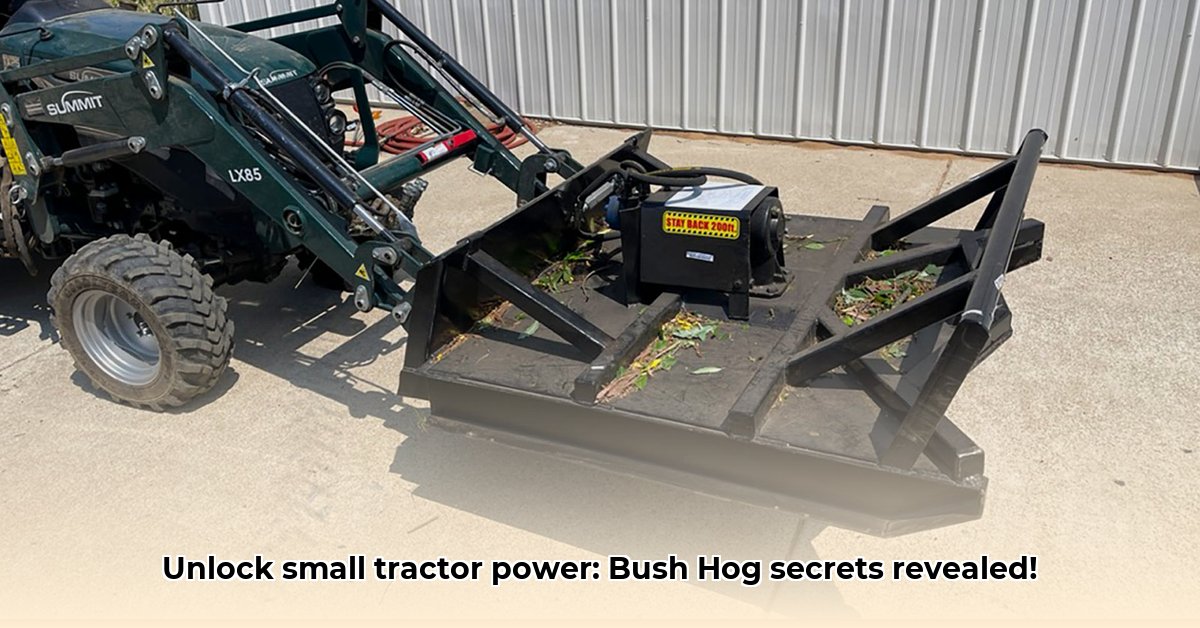
Choosing the Right Bush Hog Implement for Your Small Tractor
Selecting the appropriate Bush Hog implement is crucial for efficient and sustainable farming. The best choice depends on your specific farming goals and the capabilities of your tractor. Bush Hog offers a range of implements designed for various tasks, ensuring compatibility with tractors under 40 HP. Careful consideration of horsepower requirements is vital to avoid straining your tractor or experiencing poor performance. For more powerful options, check out heavy-duty mulchers.
What tasks are you hoping to accomplish? Are you managing pastures, clearing land, or preparing fields for planting? Different implements excel in different scenarios.
Rotary Cutters: Ideal for tackling tough vegetation like thick brush and weeds. Their powerful blades efficiently chop through heavy growth. (Cutting width: 5-7 feet; approximate HP requirement: 15-25 HP).
Finishing Mowers: Designed for a finer cut, perfect for pasture maintenance or creating a tidy finish after initial clearing. (Cutting width: 4-6 feet; approximate HP requirement: 10-20 HP).
Flail Mowers: Suitable for pasture maintenance, delicate areas, and weed control, offering less aggressive cutting than rotary cutters. (Cutting width: 4-6 feet; approximate HP requirement: 15-25 HP).
Important Note: Always consult the official Bush Hog website for the most up-to-date specifications and available models, as these can vary. Remember that mismatching implement and tractor horsepower can lead to reduced efficiency and potential damage.
Optimizing Implement Use for Sustainability
Maximizing efficiency and minimizing fuel consumption are key to sustainable farming. Here are actionable steps to optimize your Bush Hog implement’s use:
Maintain Sharp Blades: Dull blades significantly reduce efficiency and increase fuel consumption. Regular sharpening is essential. Sharp blades also contribute to a cleaner cut, minimizing soil disturbance.
Adjust Cutting Height: Set the cutting height appropriately for the terrain and type of vegetation. Cutting higher generally reduces the load on your tractor and lowers fuel usage.
Overlap Passes: Slightly overlapping passes ensures complete coverage and prevents missed spots, reducing the need for extra passes and saving fuel.
Prioritize Regular Maintenance: Cleaning and lubricating your Bush Hog implement after each use is crucial for extending its lifespan and preventing costly repairs.
Assessing the Long-Term Sustainability of Bush Hog Implements
While Bush Hog implements contribute to efficient farming, a comprehensive understanding of their long-term sustainability requires considering several factors:
Fuel Efficiency: Using a tractor appropriately sized for the task is crucial for maximizing fuel efficiency. Oversized tractors waste fuel, while undersized ones struggle.
Implement Lifespan: Proper maintenance significantly extends the life of your Bush Hog implement, reducing the need for replacements and minimizing resource consumption associated with manufacturing.
Broader Environmental Impact: While data on the comprehensive lifecycle environmental impact of Bush Hog’s manufacturing process is limited, consider the overall environmental impact of your farming practices including fuel efficiency, soil health, water usage, and carbon footprint.
Calculating Fuel Efficiency
Accurately calculating fuel efficiency helps optimize sustainable bush hogging practices. Follow these steps:
- Fill the tank completely. Record the initial fuel level.
- Bush hog a defined area. Measure the area's dimensions to calculate acreage.
- Refuel and record the amount added. This is the fuel used for the bush hogging task.
- Calculate acres per gallon: Divide the area (in acres) by the amount of fuel used (in gallons).
This calculation provides a concrete measure of your fuel efficiency, allowing you to refine your techniques for greater sustainability. Remember, factors like terrain, vegetation density, and implement condition significantly affect fuel consumption.
Conclusion: Sustainable Farming with Bush Hog Implements
Choosing the right Bush Hog implement, optimizing its use, and understanding the broader aspects of sustainability are crucial for efficient and eco-friendly farming. While readily available data on lifecycle assessments may be limited, adopting the practices outlined in this guide significantly contributes to sustainable land management and a healthier environment. Continue exploring sustainable farming practices and stay informed on advancements in the field.